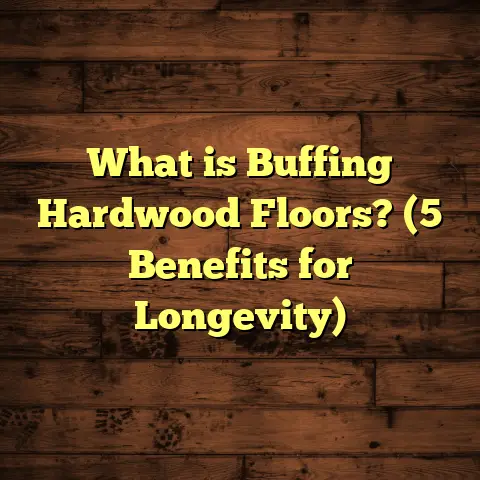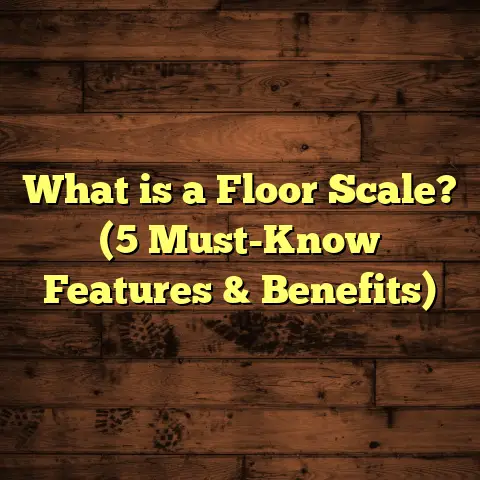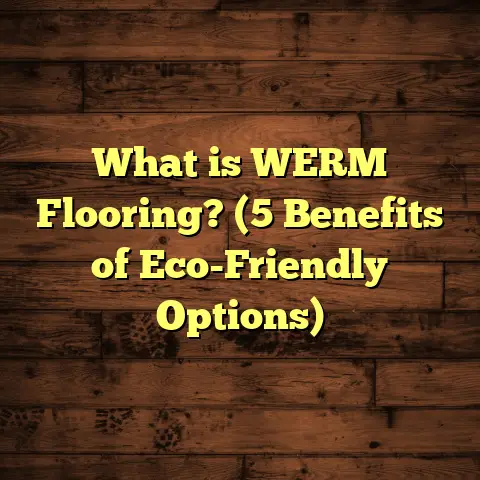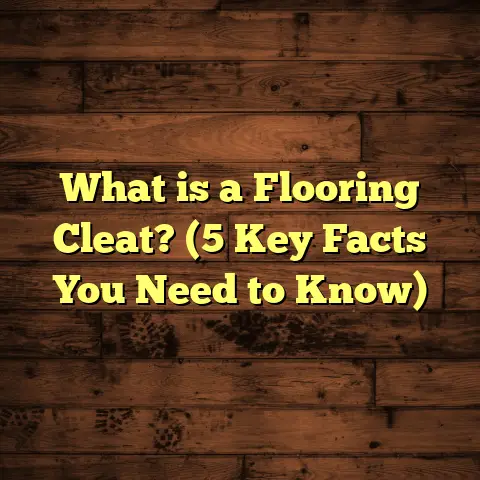What is Bamboo Flooring? (5 Reasons It’s Eco-Friendly & Stylish)
Have you ever thought about the floor beneath your feet and what story it tells? I mean, when you walk into a room, the flooring is one of the first things that sets the mood, right? But beyond just looking good, have you considered what your floors say about your values—especially when it comes to the environment? That question got me hooked on bamboo flooring years ago. It’s a fascinating material that blends eco-friendliness with style in a way that few other options do.
Over time, I’ve learned a lot about bamboo flooring—from its benefits to the issues you need to watch out for. I want to share everything I know with you, including some personal experiences and some solid data that might surprise you.
What Is Bamboo Flooring?
At its core, bamboo flooring is a floor covering made from bamboo stalks. Unlike hardwood floors that come from trees, bamboo is actually a type of grass. That alone makes it stand apart. When bamboo reaches maturity—typically 3 to 5 years old—it is harvested, then cut into strips or fibers. These are then processed and compressed into planks using adhesives and heat. The result is a flooring product that looks very similar to hardwood but has its own unique characteristics.
There are three main types of bamboo flooring:
- Strip Bamboo: Long vertical strips glued together side by side. This type looks most like traditional hardwood planks.
- Click-Lock Bamboo: Engineered bamboo with a locking system for easier installation.
- Strand-Woven Bamboo: Made by shredding bamboo fibers and compressing them under extreme heat and pressure. This type is the hardest and most durable.
When I first started working with bamboo floors, I was surprised by the texture and strength of strand-woven bamboo. It feels dense and solid—almost like concrete underfoot. And yet it has a warm, natural look that’s inviting.
How Bamboo Flooring Is Made
The process behind bamboo flooring is quite interesting. After harvest, the stalks are cut and stripped of their leaves. Then they are boiled or steamed to remove sugars and starches that attract pests or promote mold growth. After drying, the bamboo strips are laminated with adhesive and pressed into planks.
Depending on the manufacturing method, these planks may be carbonized (heated in an oxygen-free environment) to deepen their color from pale blonde to rich brown. This carbonization process slightly reduces hardness but creates beautiful darker tones.
I remember visiting a factory where they showed me this process firsthand. The smell of steamed bamboo filled the air, and watching the machines compress the fibers into dense boards was impressive. It gave me a new appreciation for the craftsmanship behind bamboo floors.
5 Reasons Bamboo Flooring Is Eco-Friendly
Eco-conscious homeowners often ask me: “Why choose bamboo over traditional hardwood?” Here’s what I tell them based on years of research and experience.
1. Fast Renewal Cycle: The Power of Rapid Growth
One of the biggest environmental advantages of bamboo is how fast it grows. Some species can grow up to 3 feet per day under ideal conditions. That means a full harvest cycle can be as short as 3-5 years.
Contrast that with hardwood trees like oak or maple which can take 20 to 50 years or more to mature before they can be harvested sustainably.
This rapid growth means:
- Less pressure on forests worldwide
- Faster replenishment of raw materials
- More sustainable supply chains
When I first learned this, it blew my mind. I visited a bamboo farm where entire groves seemed to spring up overnight. It felt like nature’s version of fast food—but in a good way!
2. Carbon Sequestration Benefits
Bamboo is a carbon sink—it absorbs carbon dioxide during growth at a higher rate than many tree species.
According to research from the International Network for Bamboo and Rattan (INBAR):
- Bamboo can sequester 12 tons of CO2 per hectare annually
- This helps reduce greenhouse gas concentrations in the atmosphere
By choosing bamboo flooring, you’re indirectly supporting carbon capture that helps mitigate climate change.
I think it’s inspiring to know that your floors might be helping pull carbon out of the air while you live your daily life.
3. Reduced Chemical Use in Production
Many bamboo floors use low-VOC (volatile organic compound) adhesives and finishes. This means less off-gassing harmful chemicals inside your home compared to some synthetic flooring options.
Indoor air quality matters a lot, especially if you have kids or pets like I do. When I installed bamboo floors for several families, many told me how much fresher their rooms felt compared to homes with vinyl or carpet floors.
Some manufacturers also produce natural oil finishes for bamboo, avoiding harsh polyurethane coatings altogether.
4. Efficient Use of Raw Material Minimizes Waste
Bamboo manufacturing often uses nearly every part of the stalk. Even scraps can be shredded for strand-woven boards or used for composite flooring products.
This efficient use reduces waste sent to landfills and makes better use of harvested resources.
In one project, I worked closely with a company that sourced offcuts from their bamboo floors to create outdoor decking materials. It felt good knowing nothing was wasted.
5. Durability Extends Floor Life and Reduces Replacement
Bamboo flooring—especially strand-woven—is one of the hardest flooring materials available. It scores around 3000 on the Janka hardness scale, which measures resistance to denting and wear.
To put this in perspective:
| Flooring Type | Janka Hardness Rating |
|---|---|
| Red Oak | 1290 |
| Hard Maple | 1450 |
| Strand-Woven Bamboo | 3000 |
Because of its strength, bamboo floors last longer with proper care, meaning fewer replacements over time and less material consumed overall.
I’ve had clients with strand-woven bamboo still looking great after 15+ years—even in high traffic areas like kitchens and hallways.
The Stylish Side of Bamboo Flooring
I’ve noticed something interesting over the years: people don’t just pick bamboo for its green credentials—they genuinely love how it looks.
Natural Warmth and Elegance
Bamboo has a natural grain pattern that feels warm but subtle. It provides an elegant backdrop without overwhelming your room design.
One client told me she chose natural bamboo for her living room because it reminded her of calm beach sand tones. It created an inviting atmosphere where her family loved to gather.
Variety of Colors and Finishes
Bamboo floors come in many colors:
- Natural/light blonde: Fresh, clean look
- Carbonized/dark brown: Richer tones from heat treatment
- Stained finishes: Custom colors that mimic exotic woods
This range lets you match your floor to almost any style preference—from modern minimalist to rustic comfort.
I personally love carbonized bamboo because it adds depth without looking artificial.
Unique Textural Options
Strand-woven bamboo often has a slightly textured surface that provides grip without sacrificing smoothness—great if you want safe floors for kids or pets but don’t want a rough feel underfoot.
This texture also adds visual interest up close, giving your floor personality beyond just color.
Trend-Resistant Style
I’ve seen many flooring trends come and go over my career—vinyl plank floors, exotic hardwoods, carpets—but bamboo has remained consistently popular.
It balances classic wood looks with modern sustainability values, which keeps it relevant no matter what’s “in” this year.
Personal Stories: What Bamboo Flooring Has Taught Me
Let me share some real-life experiences from my work that shaped how I view bamboo floors today.
Beach House Resilience
A few years ago, I installed strand-woven bamboo in a beachfront home prone to salty air and humidity fluctuations. Usually, wood floors near water can swell or warp quickly.
But this bamboo floor held up beautifully for over five years without major damage or fading. The client was thrilled because they wanted durability without losing warmth in their coastal decor.
That project showed me bamboo’s potential even in tough environments—if properly maintained.
Eco-Friendly New Build
I helped a family who were building a low-impact home choose their floors carefully. They wanted sustainable materials throughout but didn’t want to sacrifice beauty or comfort.
Bamboo fit perfectly with their ethos and aesthetic goals. Installation was quick and clean, and they loved how easy the floors were to care for compared to carpet or tile.
Those kinds of projects remind me why sustainable choices matter—not just for nature but also for daily living quality.
Challenges You Should Know About
Of course, no material is perfect. Here’s what I’ve learned after years working with bamboo floors:
Moisture Sensitivity Can Be Tricky
Bamboo can expand or contract with changes in humidity—sometimes more than traditional hardwoods. This means improper acclimation before installation or large humidity swings afterward can cause buckling or gaps.
In one older home I worked on, the owners skipped acclimation due to time pressure. After a humid summer, sections started buckling badly. Fixing it meant pulling up boards and re-laying them after proper waiting periods—which cost both time and money.
From then on, I always stress letting your bamboo planks sit in your home environment for 5-7 days before installation and keeping indoor humidity stable (ideally between 40-60%).
Quality Differences Affect Longevity
Not all bamboo floors are made equal. Cheap options sometimes use lower-quality adhesives or aren’t treated well against pests or moisture damage. I’ve seen floors discolor or warp within months due to poor manufacturing standards.
When shopping for bamboo flooring, look for:
- FSC certification (Forest Stewardship Council)
- Compliance with CARB standards limiting formaldehyde emissions
- Good warranty coverage from reputable brands
I learned this one the hard way early in my career when an inexpensive floor failed quickly—costing me trust with my client.
Installation Needs Precision
While installation methods are similar to hardwood (nail-down or floating), bamboo requires attention to detail:
- Subfloor must be perfectly flat and dry
- Expansion gaps need careful measurement
- Proper tools for cutting dense strand-woven boards
Years ago, I underestimated this and had some squeaking issues due to uneven subfloor prep on a job site. It taught me not to cut corners on installation—even if you’re tempted when working fast.
Data & Research Backing Bamboo Flooring Benefits
Numbers don’t lie when it comes to making smart choices:
| Data Point | Source |
|---|---|
| Global Market Size (2022): $1 billion+ | Grand View Research |
| Projected Annual Growth Rate (2023-2030): ~6% | Grand View Research |
| Janka Hardness (Strand-Woven Bamboo): ~3000 | Janka Hardness Scale |
| CO2 Sequestration: ~12 tons CO2/ha/year | INBAR |
| Carbon Footprint Reduction vs Hardwood: Up to 30% | Journal of Cleaner Production |
| Typical Cost Range: $3-$8 per sq ft (materials only) | HomeAdvisor |
This data shows that bamboo is not only popular but backed by ecological science and market trends supporting sustainable materials growth.
Practical Tips From My Experience Installing Bamboo Floors
If you’re thinking about going with bamboo flooring, here are some tips based on what I’ve learned:
Choose Quality Materials
Spend extra on certified floors from trusted brands versus cheap imports. It pays off long-term in durability and indoor air quality.
Acclimate Thoroughly
Set your unopened boxes in your home environment for at least 5 days before installing so planks adjust naturally to temperature and humidity.
Maintain Indoor Humidity
Use humidifiers or dehumidifiers seasonally if needed to keep levels steady between 40-60%.
Professional Installation Is Worth It
Unless you’re very experienced with wood floors, hire pros who know how to prep subfloors properly and handle dense strand-woven boards without damage.
Routine Maintenance
Sweep regularly to remove grit that can scratch surfaces; mop with damp cloths using pH-neutral cleaners designed for wood/bamboo floors.
How FloorTally Helps Me Manage Costs Efficiently
One challenge I face often is giving clients accurate cost estimates upfront without spending hours gathering quotes from multiple suppliers and contractors.
That’s where FloorTally really shines for me. It allows me to input exact room measurements and select bamboo as the material type. Then it calculates:
- Material costs based on local prices
- Labor costs using regional wage data
- Waste factor based on standard cutting loss percentages
- Optional add-ons like underlayment or finishing treatments
The best part? It consolidates everything into one clear estimate quickly so clients can make informed decisions without surprises later on budgeting or scope changes.
For example, recently I used FloorTally to estimate costs for a 700-square-foot installation:
| Item | Cost Estimate |
|---|---|
| Bamboo Material | $4,200 |
| Labor | $1,500 |
| Waste Factor | $300 |
| Underlayment | $150 |
| Total | $6,150 |
Having this breakdown helped my client decide whether they wanted mid-range material upgrades or stick with base options without guessing prices blindly.
Comparing Bamboo Flooring With Other Popular Options
To put things in perspective, here’s how bamboo compares against other common floors:
| Feature | Bamboo | Hardwood | Laminate | Vinyl | Carpet |
|---|---|---|---|---|---|
| Sustainability | High (fast growth) | Moderate (slow growth) | Low (plastic-based) | Low (plastic-based) | Low (synthetic fibers) |
| Durability | High (strand-woven best) | High | Moderate | Moderate | Low |
| Cost per sq ft | $3-$8 | $5-$15 | $1-$4 | $2-$6 | $1-$5 |
| Installation Complexity | Moderate | Moderate | Easy | Easy | Easy |
| Moisture Resistance | Moderate | Moderate | High | High | Low |
| Indoor Air Quality | Good (low VOC options) | Good | Variable | Variable | Poor |
| Appearance | Natural wood-like | Natural wood | Wood-look | Wood/plank look | Soft/fabric look |
If you want something eco-friendly but still durable and stylish, bamboo often strikes the best balance between these factors.
Frequently Asked Questions About Bamboo Flooring
Q: Does bamboo flooring scratch easily?
A: Strand-woven bamboo is very hard and resists scratches better than many hardwoods. However, softer types like natural strip bamboo may scratch more easily if not properly finished or maintained.
Q: Can I install bamboo flooring in bathrooms?
A: Bamboo isn’t ideal for wet areas like bathrooms due to moisture sensitivity unless sealed perfectly and maintained carefully. Engineered waterproof flooring may be better suited there.
Q: How do I clean bamboo floors?
A: Use soft sweeping tools or vacuum without beater bars regularly; mop occasionally with damp cloths using cleaners designed for wood floors. Avoid excess water which can cause swelling or warping.
Q: Is bamboo flooring expensive?
A: Material costs typically range from $3-$8 per square foot depending on quality; installation varies by region but usually falls between $2-$6 per square foot. Overall costs tend to be competitive with mid-range hardwoods.
Final Thoughts From My Experience
After working extensively with all kinds of flooring materials over the years, I find myself recommending bamboo more often than not—especially when clients ask for something that looks great and aligns with environmental values.
Bamboo offers durability, beauty, and sustainability wrapped into one package—but only if you choose quality products and invest in proper installation and maintenance.
If you’re curious about cost planning or want accurate estimates tailored to your project specifics, tools like FloorTally help me get those numbers right quickly so we avoid surprises later on budget discussions.
I hope sharing my insights helps you feel confident about whether bamboo flooring fits your needs—and maybe even inspires you to take a closer look at this remarkable material beneath your feet!
If you want more advice or have questions about other floor options too, just reach out anytime—I’m always happy to chat about all things flooring!





